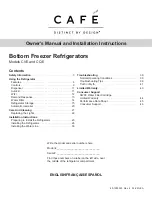
18
USING YOUR REFRIGERATOR
• The
fi
rst ice and water dispensed may include particles
or odor from the water supply line or the water tank.
• Throw away the
fi
rst few batches of ice (about 24
cubes). This is also necessary if the refrigerator has not
been used for a long time.
• Never store beverage cans or other items in the ice
bin for the purpose of rapid cooling. Doing so may
damage the icemaker or the containers may burst.
• If discolored ice is dispensed, check the water
fi
lter
and water supply. If the problem continues, contact a
Sears or other quali
fi
ed service center. Do not use the
ice or water until the problem is corrected.
• Keep children away from the dispenser. Children may
play with or damage the controls.
• The ice passage may become blocked with frost if only
crushed ice is used. Remove the frost that accumulates
by removing the ice bin and clearing the passage with
a rubber spatula. Dispensing cubed ice can also help
prevent frost buildup.
• Never use thin crystal glass or crockery to collect ice.
Such containers may chip or break resulting in glass
fragments in the ice.
• Dispense ice into a glass before
fi
lling it with water
or other beverages. Splashing may occur if ice is
dispensed into a glass that already contains liquid.
• Never use a glass that is exceptionally narrow or
deep. Ice may jam in the ice passage and refrigerator
performance may be a
ff
ected.
• Keep the glass at a proper distance from the ice outlet.
A glass held too close to the outlet may prevent ice
from dispensing.
• To avoid personal injury, keep hands out of the ice
door and passage.
• Never remove the dispenser cover.
• If ice or water dispenses unexpectedly, turn o
ff
the
water supply and contact Sears Home Service at
1-800-4-MY HOME
®
.
CAUTION
AUTOMATIC ICEMAKER (continued)
















































